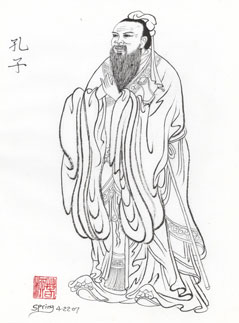- East Asia’s “Post-Confucian” societies
- Chu Hsi (Zhu Xi) emails
- MM as Confucian, Neo-Confucian and Post-Confucian
- Confucianism in 21st-century Chinese academic discourse
APPENDIX 1: Confucius and the Classic Texts
APPENDIX 2: Confucianism in early 20th-century China

Confucius and the Classic Texts
The first of the Five Classics in traditional order is the Book of Songs. Also called the Book of Poetry, it contains 305 poems that Confucius selected from among 3,000 dating from the tenth to the seventh century B.C. Of the 305, many are charming folk lyrics, while others are political poems and ritual hymns used on governmental ceremonial occasions.
The Book of History consists of historical and semi-historical documents such as short announcements and oral reports supposedly made by rulers and their officials, and dating from early Chou. The Book of Changes is also known as the Book of Divination, because it was used for this purpose. The Book of Rites is the most Confucian of the Five Classics.
Most of it was written after Confucius’ death. The last of the Five Classic is the Spring and Autumn Annals, a brief chronicle of major events that took place in Confucius’ native state of Lu during the period from 722 to 481 B.C. All these classics were eventually revered as bibles of the school of Confucian thought. Later tradition attributed them to Confucius.
The best known of the central Confucian texts is the Lun Yu (or Analects). MM incorporates selections in his Engendering. Some regard the Mencius as an even more Confucian work, especially for its advice regarding government. To these two books were added two more, in the edition of Confucian books made by Chi Hsi in the Sung dynasty.
The Great learning and the Doctrine of the Mean embrace the most profound philosophical essence of Confucianism. (These two books were originally chapters in the Book of Rites.) The Four Classics take up the perfection of the Confucian Gentleman and address problems of public morality. They were intended primarily for scholars.
Confucius urged rulers to return to the ancient Way or to follow the exemplary age when hereditary kings governed a simple agrarian society by means not of force but through their virtuous example. “Let the ruler be a ruler and the subject, a subject; the father, a father; the son, a son.” Confucius reiterated the hierarchical order based upon the Five Relations.
Confucianism in early 20th-century China